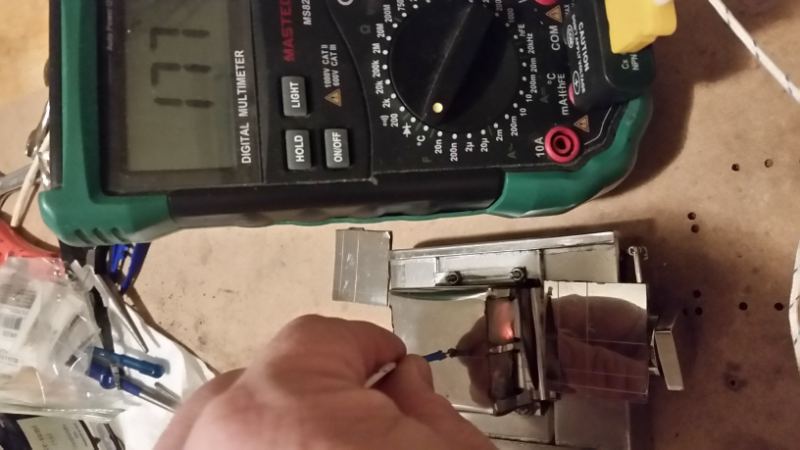Batteries are a really useful way to store energy, but their energy density in regards to both weight and volume is disappointing. In these regards, they really can’t compete with fossil fuels. Thus, [bryan.lowder] decided to see if he could charge a phone with fossil fuels as safely and inoffensively as possible.
Obviously, with many national grids relying on fossil fuels for a large part of their generation, most of us are already charging our phones with fossil fuels to some degree. However, the aim here was to do so more directly, without incurring transmission losses from the long runs through the power grid.
The system works by catalytically oxidizing so-called white camping fuel, which is closely related to the gasoline we run in our cars. This oxidation process generates heat but at sub-flame temperatures, thus avoiding the mess and danger of regular combustion. This heat is then used to power a thermoelectric generator (TEG) in much the same way as NASA relies on radioisotopes to do the same job.
The device emits fumes, but less than burning gasoline would do. There’s no fire involved, and it’s largely silent. The fuel itself is stored in a hip flask, with vapors passing through the catalytic material and heating the thermoelectric generator to around 180°C. A regulator then bumps the voltage output to 5V and passes it to a USB port for charging a phone.
[bryan.lowder] hasn’t provided details on the performance of the build, yet. We’re keen to see the numbers, as the low efficiency of TEGs would mean that quite a volume of fuel would likely be required to charge the phone.
We’ve seen liquid fuels touted before as a compact source of electricity, often in combination with fuel cells. The technique is yet to catch on en masse, but if you’re tinkering in this area, be sure to let us know!
















I’m curious just what is in the exhaust.
carbon monoxide, carbon dioxide, water, and unreacted fuel with elevated additive content due to in process refining. Ideal the latter would be condensed, separated, and the usable fraction reintroduced to the fuel cell.
oops, fueled TEC….I thought it was a solid oxide gasoline fuel cell..sorry wish it was a wachman, Still cool though
CO2. H20 and CO. Maybe some other stuff that’s in gasoline.
Catalyst probably platinised asbestos
Poor man’s fuel cells.
I thought a company was doing development using lighter fluid.
Lighter fluid and white gas are both naphtha. I tried to get my control systems prof in college to let me do a regulated power supply based on a butane lighter and TEG, but he wasn’t comfortable with me bringing fire into his lab. Naphtha instead of butane does reduce the pressurized gas hazard, but I don’t know if throwing a catalyst in would have tipped the scales or not.
Or you could just y’know burn it and get much better power density and efficiency. The greater the heat difference the better the efficiency
And the stronger the offensive aroma that comes with burning gasoline rather than letting it just heat up and evaporate
Wouldn’t you expect the aroma to be stronger in the non-combustion case as some amount of unburned fuel is in the exhaust gas mixture, as opposed to burning where less unburned fuel makes its way into the exhaust?
I always wanted a phone with a kickstart.
My brain hurts.
Why not a potato?
Challenge accepted!
Hot on the heels of the Copper-shortage post that unleashed every climate science denier on Hackaday, comes another pro-fossil fuels hack, but this time with bonus Carbon Monoxide. Crumbs, I’m half expecting future Lewin Day items to be accompanied by a sponsorship message from the Heartland Institute, extolling the virtues of lead and the wonderful cooling properties of horizon to horizon NOx ;-) .
If a cup of ice water melts, does it overflow the cup?
No, but that’s because the ice in a glass of ice water is FLOATING in the water, so it displaces the same amount solid as it does liquid. The Antarctic and Greenland ICE CAPS, on the other hand are sitting on top of land, so they DO raise the sea level when they melt. I can’t believe nobody has explained this to you before.
This is similar to what Zippo does with their catalytic hand warmers. They use the same lighter fluid as the lighters but rely on a replaceable catalytic cartridge in an otherwise similar body to a lighter’s. It’s not very stinky, barely noticeable aroma but the heat generated is significant.
Zippo was a late entrant by almost a century. The catalytic handwarmer was commercialized in japan in the early 1920s and was exported to the US after WWII.
Thank you Brother for ingenuity in supposing the several nations’ lifeblood: black gold!
Far from ideal, but in a pinch it burns less gas than firing up the Honda for an hour to charge your phone. Provided you even have that, or it isn’t frozen or under water. See: every natural disaster.
White gas – naphtha, it’s not the same as modern gasoline. Is a much purer product. With no concerns about octaine. Not that it matters too much, but a fact that seemed to go over the OPs head. There are a few devices that use white gas that can but used indoors with ventilation. Stoves lanterns, personal heaters ECT.
Et cetera – etc
An advert, but very relevant: https://www.youtube.com/watch?v=Nn__9hLJKAk